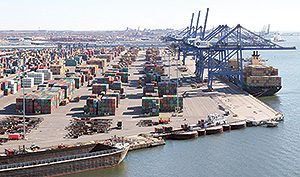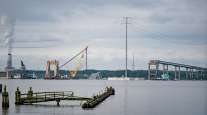Senior Reporter
Baltimore’s Tradepoint Atlantic Intermodal Facility Transforms Old Bethlehem Steel Site

[Stay on top of transportation news: Get TTNews in your inbox.]
Beginning in 1887 and for more than 120 years, blue-collar workers at Sparrows Point in Baltimore made some of the finest steel at the largest steelmaking operation in the world.
Today, new uses are being developed for the site, and they will have important implications for the trucking and logistics industry. In 2014, development company Tradepoint Atlantic bought the waterfront site for a bargain-basement price of $110 million. It’s now being turned into what will be more than a $2 billion multimodal facility serving the East Coast and Midwest.
“Given the diversity of the cargo at the Port of Baltimore, we get to be the expansion and growth mechanism for the port for the next couple of decades, if not longer,” Tradepoint Atlantic Chief Commercial Officer Kerry Doyle said.

Seagirt Marine Terminal at the Port of Baltimore by Fatlouie/Wikicommons.
One-third of the nation’s population is a one-day drive by truck from Baltimore, and the developers said that’s the key.
Besides the waterfront access, there already is a short-line freight railroad in place with connections to Class I railroads CSX and Norfolk Southern, and a dedicated interstate highway entrance and exit on Interstate 695. Approval was just granted to establish a heavy-truck corridor on which overloaded trucks can be permitted to move containers up to 100,000 pounds along an 8.6-mile route from Tradepoint Atlantic to the Seagirt Marine Terminal, which is part of the Port of Baltimore.
While Tradepoint Atlantic is years from being completed, a number of high-profile companies already have built large warehouses and other facilities.
“This is symbolic of where I think our economy is going: the demand-driven, I-want-it-at-my-door-in-24-hours mentality,” Tradepoint Atlantic Senior Vice President Aaron Tomarchio said. “A lot of big, blue-chip companies are in the process of making this transformation.”

Loading docks at Tradepoint Atlantic's Sparrow’s Point Warehouse in Baltimore by Dan Ronan/Transport Topics.
Baltimore’s own sports apparel giant, Under Armour, has a 1.3 million-square-foot facility. Amazon built a $250 million fulfillment center on-site. The Home Depot, Floor & Decor, FedEx, Perdue AgriBusiness and Volkswagen also have inked deals.
The addition of Volkswagen is significant because the German auto giant is putting in a 150,000-square-foot vehicle processing center there. The nearby Port of Baltimore is the nation’s leader in that segment, handling more than 800,000 autos and light trucks in 2018, and other roll-on/roll-off cargo.
“We do everything from automobiles import/export, we do break bulk, which is primarily aluminum, steel, palletized-type cargo. We also do a large volume of dry bulk. We also do liquid bulk,” Tomarchio said.
Seven years ago, the last company to make steel at Sparrows Point filed for bankruptcy. The plant that once had more than 30,000 employees during its peak closed, and the remaining 2,000 jobs were gone forever.
In late 2018, developers received $78 million in funding from Baltimore County to assist with rebuilding some of the roads, along with replacing the outdated water and sewer systems. The surrounding infrastructure harkens back to the glory days of the U.S. steel industry.


Views of the old Bethlehem Steel plant by Dan Ronan/Transport Topics.
Bethlehem Steel bought the plant in 1918 when American production was at its peak. Girders that hold up San Francisco’s iconic Golden Gate Bridge. Cables that support New York’s George Washington Bridge. Steel from the plant can be found in countless skyscrapers and ballparks. The workers made steel that was a critical part of the U.S. effort in World War I and World War II. The Sparrows Point shipyard was one of the nation’s busiest, delivering 116 ships from 1939 to 1946. During the war, American workers helped rebuild the British Merchant Navy.
In 2012, with those glory days of domestic steel production rapidly fading, the 3,250-acre site on the Patapsco River near the Port of Baltimore was heavily polluted and on its fifth owner in 10 years. New owner after new owner — including current Commerce Secretary Wilbur Ross and his company — promised to restore the old plant to its past glory, even as imported steel from China and other countries was cheaper to produce.
Getting Tradepoint Atlantic to the point at which the land can be safely reused for any purposes, let alone logistics, has not been easy, especially when it concerns the environment. After years of making millions of tons of steel in blast furnaces, the site was heavily polluted and nearby Bear Creek was a toxic mess. When an environmental impact study was done, the land and water were found to be a witch’s brew of dangerous chemicals.
“One hundred twenty-five years ago, there was no EPA. They were doing things differently than an industrial process would do now, so there was an environmental legacy the people were concerned about,” Tomarchio said. “We were able to reach agreements with the [Maryland Department of the Environment] and EPA that we would fund the cleanup, but we would be protected from the past sins that were done then.”
While many of the workers who toiled at Sparrows Point during its final years creating steel have retired or moved on, the new developers say the project already has created 5,000 jobs. Once completed, it will have created as many as 17,000 jobs, many directly tied to the trucking and logistics industries.
“We are about 50% complete,” Doyle said. “We have plenty of real estate and warehouse capacity to expand.”




